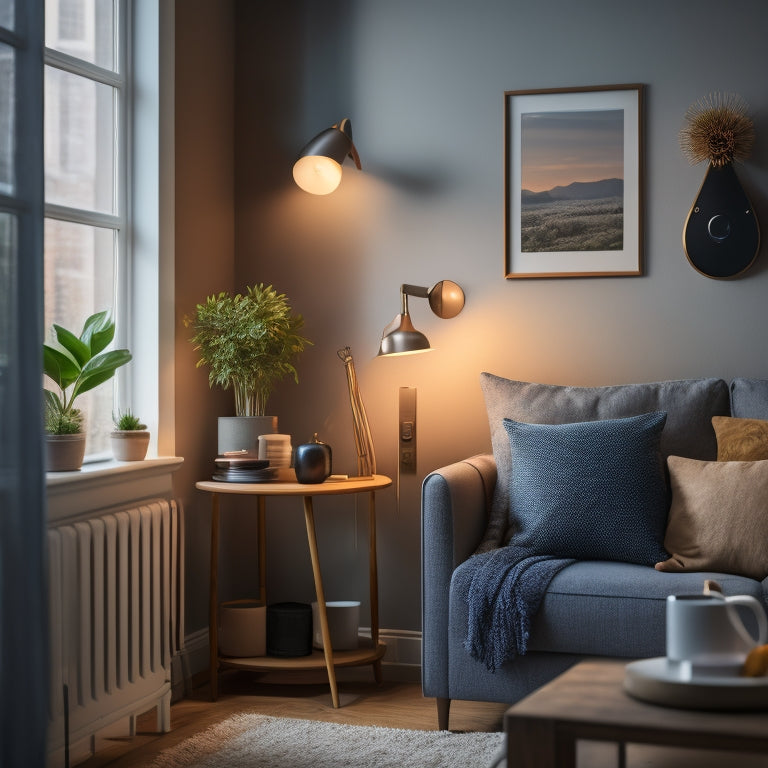
Best Smart Home Devices for Beginners
Share
If you're new to smart home devices, start with user-friendly options like smart speakers, smart plugs, and smart lighting. These devices offer easy installation and connect effortlessly to your Wi-Fi. Look for intuitive mobile apps that allow voice control and remote management, enhancing convenience. Remember to reflect on your goals—whether it's security, energy efficiency, or just automation. Choose products that integrate well with platforms like Alexa or Google Assistant for seamless operation. By focusing on cost-effective devices, you'll enjoy the benefits of automation without breaking the bank. Stick around to uncover more tips and device recommendations!
At a Glance
- Start with user-friendly devices like smart plugs, lights, and speakers for easy installation and basic automation.
- Choose devices with intuitive mobile apps that support voice control and remote access for seamless management.
- Look for essential features such as scheduling, automation, and compatibility with other smart devices to enhance functionality.
- Consider budget-friendly options and research cost-effective devices to achieve your smart home goals without overspending.
- Define your smart home goals, assess device compatibility, and prioritize products that integrate with platforms like Alexa or Google Assistant.
User-Friendly Setup Process
Setting up smart home devices doesn't have to be complicated. Most devices come with easy installation steps, making the process straightforward for anyone.
Additionally, considering energy storage solutions can enhance the efficiency of your smart devices, allowing for optimal battery performance and extended usage during power outages.
Plus, intuitive mobile apps guide you through each step, ensuring you're up and running in no time.
Easy Installation Steps
Installing smart home devices doesn't have to be an intimidating task; in fact, many models are designed with beginners in mind, making the process straightforward and user-friendly.
To get started, you'll want to verify your home has a reliable wireless connectivity setup. This means checking your Wi-Fi signal strength in the areas where you'll install devices.
Next, unpack your device and read through the quick-start guide. Most devices are designed for easy installation, often requiring just a few steps. You'll typically need to download a companion app, which helps you connect to your Wi-Fi network and guides you through the setup process.
When choosing devices, consider their compatibility with each other and your existing smart home ecosystem. Many devices seamlessly integrate, allowing you to control them all from one app, enhancing your experience and convenience.
Follow on-screen prompts, and you'll often find that connecting to your wireless network is as simple as entering your password.
Once set up, you can start enjoying the freedom and comfort that smart home technology offers, converting your living space into a more efficient and automated environment.
Intuitive Mobile Apps
A user-friendly mobile app can make all the difference when setting up your smart home devices. With intuitive design and straightforward guidance, these apps enable you to take control of your home effortlessly. You want to feel liberated, not overwhelmed, and a great app streamlines the process, directing you every step of the way.
Look for apps that allow you to easily connect multiple devices, whether it's smart lights, thermostats, or security cameras. Voice control integration is essential, letting you manage your home hands-free. Just imagine saying, "Turn off the lights," and watching them dim instantly!
Remote access is another transformative element. You can monitor and control your devices from anywhere, giving you peace of mind. If you're away on vacation, you can check in and adjust your settings, making it look like you're home.
Ultimately, an intuitive mobile app turns complex setups into a breeze. Choose devices that offer seamless app experiences, and you'll reveal the true potential of your smart home.
Enjoy the flexibility and convenience that comes with mastering your living space, all at your fingertips!
Cost-Effective Home Automation
When you're looking to automate your home without breaking the bank, there are plenty of affordable smart devices on the market.
Investigating options like energy storage capacity can enhance your automation experience by integrating solar panel systems with smart technology.
You can also examine budget-friendly automation tips that maximize your investment.
With a little research, you'll find ways to enjoy the benefits of smart technology without overspending.
Affordable Smart Devices
Affordable smart devices can change your home into a tech-savvy haven without breaking the bank. You don't need to spend a fortune to enjoy the benefits of home automation.
Start with smart lighting, which allows you to control your lights via your smartphone or voice assistants like Amazon Alexa or Google Assistant. Simply set the mood with a voice command or schedule your lights to turn on and off automatically, enhancing both convenience and energy efficiency.
Another cost-effective option is a smart plug. These handy devices let you control non-smart appliances remotely, giving you greater control over your home environment. Imagine turning off that lamp or coffee maker from anywhere with just a tap on your phone or a simple voice command.
Don't forget about smart speakers. They not only serve as voice assistants but also act as hubs for your other smart devices. You can play music, check the weather, or even manage your smart lights all through simple voice commands.
Budget-Friendly Automation Tips
Often overlooked, budget-friendly automation tips can make a significant difference in enhancing your home's functionality without draining your wallet. One of the easiest ways to start is by focusing on energy efficiency tips. Consider smart plugs that allow you to control devices remotely and schedule them to turn off when not in use. This simple change not only saves energy but also reduces your monthly bills.
Next, investigate remote monitoring solutions. You can find affordable cameras and smart doorbells that offer peace of mind without the hefty price tag. These devices let you keep an eye on your home from anywhere, giving you the freedom to relax while knowing everything's secure.
Additionally, look into smart LED bulbs, which can be controlled via an app. They're energy-efficient and let you customize lighting to suit your mood or activity.
Lastly, leverage free automation platforms that allow you to link various devices. This way, you can create routines without investing in expensive hubs.
Key Functionalities Overview
When exploring smart home devices, two key functionalities stand out: essential device features and user-friendly interfaces.
You want devices that not only perform well but are also easy to control and integrate into your daily routine.
Additionally, keeping your smart home devices in peak condition, similar to battery maintenance tips for longevity, can enhance their performance and reliability.
Understanding these elements will help you make informed choices and enhance your home automation experience.
Essential Device Features
A variety of essential features can alter your smart home experience, making it both convenient and efficient. When you choose smart home devices, look for key functionalities that enhance your lifestyle. Here's a quick overview of must-have features:
| Feature | Description | Benefits |
|---|---|---|
| Smart Lighting | Control lights remotely or automate them | Saves energy, enhances security |
| Voice Control | Use voice commands for device interaction | Hands-free convenience |
| App Integration | Sync devices with smartphone apps | Centralized control |
| Scheduling | Set timers for devices to operate | Customizes your routine |
| Compatibility | Works with other smart devices | Expands your smart ecosystem |
These features not only improve the functionality of your devices but also provide you with a seamless experience. For instance, smart lighting allows you to adjust brightness and color with a simple voice command, while scheduling can automate your home's energy use. By focusing on these essential device features, you can create a smart home that aligns with your desire for freedom and flexibility. Welcome the possibilities and reshape your living space today!
User-Friendly Interfaces
User-friendly interfaces are essential for making smart home devices accessible and enjoyable for everyone. When you choose devices with intuitive controls, you enable yourself to take full advantage of their features without frustration. Look for options that emphasize simplicity, such as touchscreens with clear layouts and easy guidance.
Voice control is a revolutionary feature in this domain. Imagine simply saying, "Turn on the lights," and watching your home respond. This hands-free functionality not only enhances convenience but also promotes a sense of freedom, allowing you to multitask without being tethered to your devices.
Moreover, consider accessibility features that accommodate diverse needs. Smart home devices equipped with options like adjustable text sizes, high-contrast displays, and audio descriptions make them usable for everyone, regardless of ability. These thoughtful features guarantee no one feels left out in the smart home revolution.
Ultimately, the best user-friendly interfaces make it easy for you to engage with your smart home, turning it into a seamless extension of your lifestyle.
Identify Your Smart Home Goals
Identify Your Smart Home Goals
Before you start shopping for smart home devices, it's essential to define your specific needs. Consider what areas of your home you'd like to enhance—security, convenience, or energy efficiency—and set a realistic budget.
Reviewing your energy usage and exploring options for assessing energy needs can also help in determining which smart devices may be most beneficial. Knowing these factors will help you make informed decisions and choose the right devices for your lifestyle.
Define Your Needs
Identifying your smart home goals is essential to creating a space that truly enhances your lifestyle. Start by asking yourself what you want to achieve. Are you looking to increase convenience, improve security, or save energy? Each goal will guide your choice of smart home essentials.
Next, prioritize features that matter most to you. If energy efficiency is a priority, consider smart thermostats and lighting that adapt to your habits. For security, smart cameras, doorbells, and locks can provide peace of mind. Think about how each device can simplify your daily routine.
Also, consider the compatibility between devices. A cohesive system lets you control everything seamlessly, whether through voice commands or a central app. Remember, there's no one-size-fits-all solution; it's about what fits your lifestyle best.
Lastly, don't rush into buying too many devices at once. Focus on a few key components that align with your goals. This approach allows you to gradually expand your smart home ecosystem, ensuring each addition truly serves your needs.
Budget Considerations
Once you've defined your smart home goals, it's time to evaluate your budget. This step is vital to guarantee you don't overspend while still achieving the convenience and efficiency you desire.
Start by listing the devices that align with your goals, then research their costs. It's easy to get carried away, so consider implementing cost-saving strategies. Look for bundles or discounts, and don't forget about second-hand options that still meet your needs.
Next, incorporate budget tracking into your plan. Use apps or spreadsheets to keep tabs on your spending. This way, you can see where your money's going and make adjustments as needed.
You might uncover areas where you can cut back or prioritize investments that provide the most value.
Seamless Integration With Existing Devices
When it comes to smart home devices, compatibility with major brands is key to achieving a seamless experience.
You'll want to guarantee that your new gadgets work well with the systems you already have in place.
This way, you can easily control everything from one app or voice command, simplifying your daily routines.
Compatibility With Major Brands
As you immerse yourself in the world of smart home devices, ensuring compatibility with major brands can make all the difference in creating a seamless, interconnected environment. You want your devices to work together effortlessly, forming a smart ecosystem that enhances your lifestyle.
Look for products that boast strong brand compatibility, allowing you to mix and match devices from different manufacturers without a hitch.
When choosing smart home devices, consider those that integrate well with popular platforms like Amazon Alexa, Google Assistant, or Apple HomeKit. These ecosystems provide you with flexibility and control, enabling you to customize your setup to suit your needs.
For example, smart lights that can be controlled through your existing voice assistant provide convenience and functionality.
Don't forget to check if your devices can communicate with one another — interoperability is essential for a truly smart home experience.
By prioritizing compatibility, you're not just investing in individual gadgets; you're building a cohesive system that gives you the freedom to expand and adapt over time.
Welcome the possibilities, and enjoy the seamless integration that comes from smart home devices designed with brand compatibility in mind.
Frequently Asked Questions
What Are the Best Smart Home Devices for Beginners?
When exploring smart home devices, consider those with smart assistant features for easy control. For a beginner setup, start with voice-activated speakers and smart bulbs—these offer simplicity and flexibility for your home automation expedition.
How Do I Ensure Privacy With Smart Home Devices?
Isn't your privacy worth protecting? To guarantee it with smart devices, use data encryption and regularly check user permissions. You control what information's shared, so take charge and safeguard your personal space effectively.
Can I Control Smart Devices Without Wi-Fi?
Yes, you can control smart devices without Wi-Fi using Bluetooth connectivity or the Zigbee protocol. Both options allow you to manage devices directly, giving you freedom and flexibility even when your internet's down.
Are Smart Home Devices Energy Efficient?
Imagine your smart thermostat adjusting the temperature based on your habits. You'll enjoy significant energy savings compared to traditional systems. By conducting a device comparison, you'll see how these devices enhance efficiency and reduce costs.
What Happens if My Smart Device Malfunctions?
If your smart device malfunctions, don't panic. You can follow troubleshooting tips, like resetting or checking connections. Many users share their experiences online, helping you find solutions and regain control over your smart home setup.
Explore More
In your expedition to create a smart home, remember that each device is a stepping stone toward a more convenient lifestyle. By focusing on user-friendly options that fit your budget and goals, you're not just automating your home; you're enhancing your daily life. As you integrate these devices, consider how they can change your routines, making every moment a little smarter. After all, isn't a more connected home the foundation of a more connected life?
Related Posts
-

What Types of Solar Energy Devices Are Available
You'll find several types of solar energy devices available today, each customized to different energy needs. Photovo...
-

Renewable Energy Solutions to Reduce Your Carbon Footprint
To reduce your carbon footprint, adopting renewable energy solutions is key. Using solar panels or wind turbines can ...
-

Applications of Photovoltaic Systems
Photovoltaic systems are versatile, converting sunlight into electricity for various applications. You can use them i...


